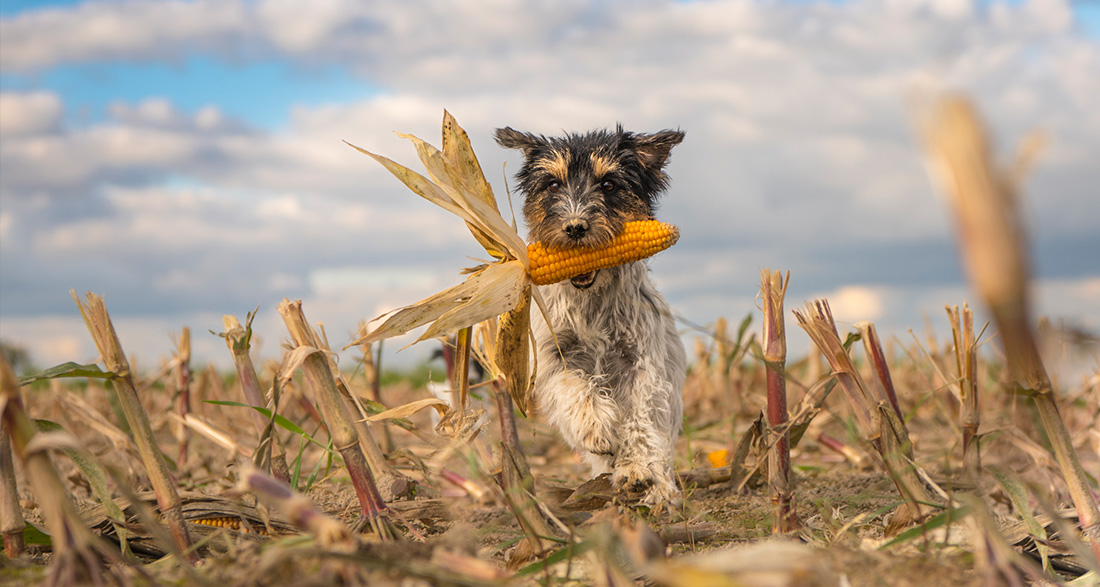Cornfields—a danger often underestimated by dog owners. Were you aware that it could be life-threatening for your canine companion if he eats the cob of a corn ear? And that’s not the only threat lurking in cornfields between September and November for your dog. We’ll give you three reasons why your dog shouldn’t be in cornfields and how to react in case of an emergency.
Corn Cobs: Beware of Intestinal Blockage
Emergency in a veterinary practice: A dog having trouble defecating and experiencing severe abdominal pain is brought to the vet. The examination reveals that he has swallowed the core of a corn cob. A portion of the intestine must be surgically removed. The problem: the indigestible core has become lodged in the intestine, severely damaging a section of it.
Whether from personal experience in dog ownership or through customer testimonials, the danger of cornfields for dogs is known to Monica, a iHugDogs veterinarian. Therefore, the advice is, “Corn cobs, whether from the field or the grill, are off-limits for dogs. The risk of the core becoming lodged in the dog’s intestine is significant. And then, only surgery can help. While the costs are covered by dog insurance, it’s better not to let it come to that. Even if you’ve been lucky so far, and nothing has happened to your dog.”
How to Recognize Intestinal Blockage?
Of course, it can happen that your dog swallows a foreign object, leading to intestinal blockage. In such cases, prompt action is required. If the intestinal blockage remains undetected for too long, it can be fatal for your furry friend.
Symptoms of Intestinal Blockage:
- Your dog has abdominal pain.
- His abdomen is hardened.
- He eats very little.
- His temperature is elevated.
- He vomits but cannot defecate.
If your dog exhibits such symptoms, you should immediately take him to the veterinarian. If you wait too long, parts of the intestine may die. In extreme cases, the intestine may even rupture, leading to a life-threatening peritonitis.
Info:
Chestnuts are another underestimated danger for many dog owners, in addition to corn cobs. They are ideal for a spontaneous game of fetch. However, if your furry friend swallows a chestnut, it can block the small intestine.
Corn Leaves: Caution, Razor Sharp!
Not only corn cobs but also the leaves and stalks can be dangerous for your dog. They are razor-sharp. If you let your four-legged friend run through a cornfield, he might come back with deep cuts. While these injuries are generally not lethal, they are extremely painful. Moreover, the wound could become infected, leading to blood poisoning, especially if left untreated.
Caring for Dog Cuts:
For both large and small cuts, clean and disinfect the wound. If the wound continues to bleed after about 10 minutes, take your dog to the vet promptly. For smaller wounds:
- Remove the fur around the wound to get a better view and prevent the fur from contaminating the injury.
- Clean the wound with lukewarm water and disinfectant, using a non-fuzzy cloth.
- Apply wound spray or ointment.
- Prevent your dog from licking the wound, as it disrupts the healing process. Consider using a collar if necessary.
- Regularly check the wound. If it becomes infected, visit the vet!
Cornfields: Beware, Wild Boars Ahead!
Did you know? Wild boars often hide behind the tall stalks and enjoy munching on corn. Naturally, they don’t want to be disturbed. Therefore, it’s better not to startle them. Once a wild boar gets agitated, it can seriously injure your dog and even you.
Encounter with Wild Boars – Tips:
You should generally be cautious of wild boars during your dog walks, especially in forests or on field paths. Dogs are a red flag for wild boars since they are descendants of their natural enemy, the wolf. It’s possible that a wild boar might attack you and your dog, especially if it feels disturbed during feeding. In such cases:
- Stand still.
- Move slowly backward.
- Avoid getting too close to the wild boar.
- Offer it an escape route.
- Under no circumstances should you run away.
If the wild boar remains agitated and has already targeted you or your dog with loud snorting, raised tail, and chattering teeth, then:
- Make yourself appear larger.
- Clap your hands.
- Yell and stamp on the ground.
- Make yourself noticeable by any means.
Conclusion: Why Cornfields Are Off-Limits for Dogs
Corn is tasty, no doubt. However, you should keep your dog away from cornfields. Why? Well, for one, you are damaging someone else’s property by letting him run through the field. Moreover, it’s quite dangerous for him, as the following three reasons illustrate:
The leaves and stalks are very sharp. If your dog runs through a cornfield, he can get cut by them. These cuts are extremely painful, and if they become infected, it can be dangerous for your dog.
While your dog frolics and plays in the field, he may encounter wild boars, which are not happy when disturbed during their meal.
The core of the corn cob is indigestible. If swallowed by dogs, it is highly likely to cause intestinal blockage.
Our iHugDogs request in conclusion:
Warn other dog owners about the dangers of cornfields. Also, make people aware of the risks if you notice fellow dog lovers letting their dogs romp through the fields. Take good care of your furry friend and consider keeping them leashed near cornfields.


